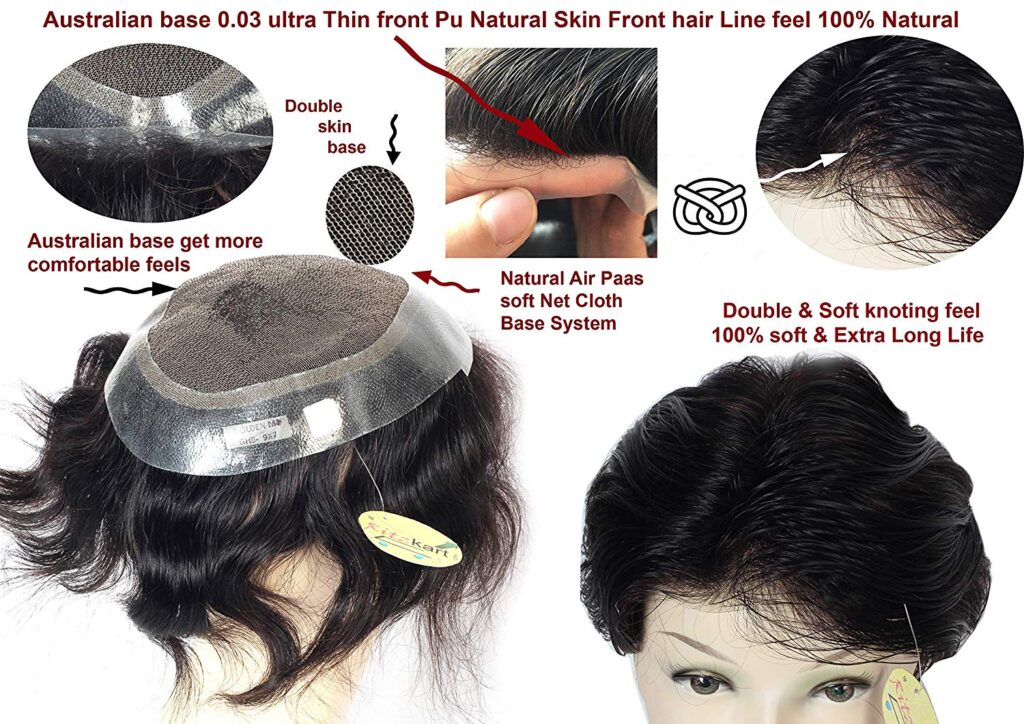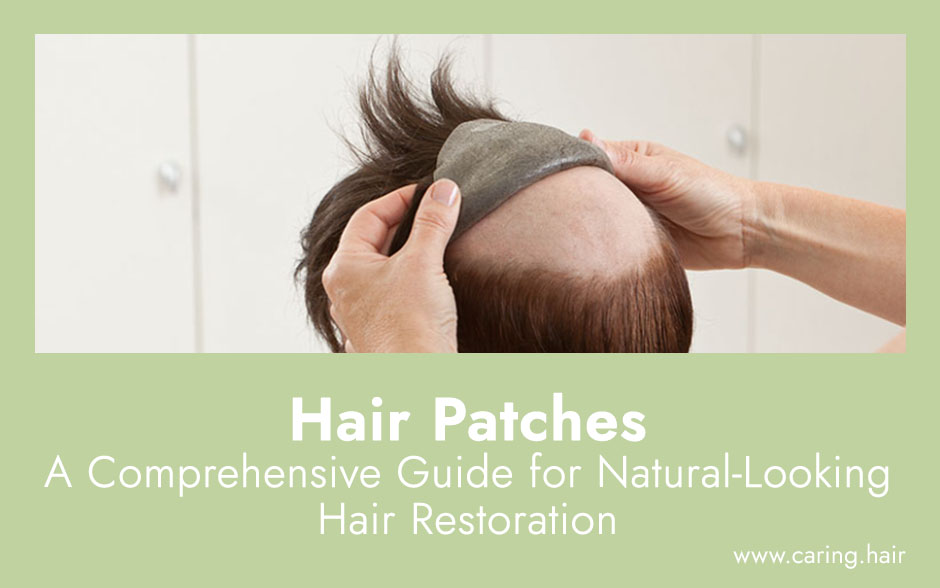Are you looking for a natural-looking solution for your hair loss but don’t have the time or budget for a hair transplant? Are you tired of wearing wigs that never quite look or feel right? It’s time to consider a hair patch, the perfect alternative that can give you the appearance of natural hair in no time at all. Whether you’re experiencing partial or complete hair loss, a hair patch can be an affordable and effective solution that looks and feels just like your own hair. In this article, we’ll dive into everything you need to know about hair patches, including the different types available, cost, maintenance, and more. So, if you’re ready to say goodbye to wigs and hello to a natural-looking head of hair, keep reading!
1. What is a Hair Patch?

A hair patch is a non-surgical hair loss solution that involves attaching a hairpiece or a toupee to the scalp with the help of adhesives, clips, or tapes. Hair patches are made of natural or synthetic hair strands, and they come in various sizes, colors, and styles to suit different hair types and preferences. Unlike wigs, hair patches are designed to cover only the balding areas of the scalp, giving a natural and seamless look.
2. Types of Hair Patches
There are two main types of hair patches: ready-made and custom-made. Ready-made hair patches are pre-designed and available in standard sizes and styles, while custom-made hair patches are tailored to fit your scalp size and hairline. Custom-made hair patches are more expensive than ready-made ones, but they offer a more natural look and a better fit.
3. Benefits of Wearing a Hair Patch
Wearing a hair patch has several benefits, including:
- Instant Results: Unlike hair transplant surgery, which may take months to show results, hair patches provide an instant solution to hair loss. You can see the difference right after wearing it.
- Natural Look: Hair patches are designed to match your hair color, texture, and style, giving a natural and seamless look.
- Cost-Effective: Hair patches are relatively affordable compared to hair transplant surgery or other hair loss treatments.
- Low Maintenance: Hair patches require minimal maintenance, and you can easily style them as per your preference.
- Versatile: Hair patches come in different sizes, styles, and colors, making them suitable for various occasions and lifestyles.
4. How to Choose the Right Hair Patch?
Choosing the right hair patch is crucial to get a natural and comfortable look. Here are some factors to consider while selecting a hair patch:
- Hair Type: Choose a hair patch that matches your hair type, whether it’s straight, curly, or wavy.
- Hair Color: Select a hair patch that matches your natural hair color, or you can opt for a color that complements your skin tone.
- Hair Style: Choose a hair patch that suits your face shape and style preference.
- Size and Fit: Measure your scalp size and choose a hair patch that fits comfortably and securely.
5. How to Maintain a Hair Patch?
Maintaining a hair patch is relatively simple and requires minimal effort. Here are some tips to keep your hair patch in good condition:
- Clean your hair patch regularly with a mild shampoo and conditioner.
- Avoid using hot water or blow dryer on your hair patch.
- Use a soft-bristle brush or comb to style your hair patch gently.
- Avoid sleeping on your hair patch and cover it with a silk scarf or cap at night.
- Replace the adhesive tapes or clips regularly to ensure a secure fit.
6. How Long Does a Hair Patch Last?
The longevity of a hair patch depends on several factors, including the quality of the hairpiece, the maintenance, and the frequency of usage. On average, a hair patch can last anywhere from six months to a year. However, with proper care and maintenance, you can extend its lifespan up to 18 months.
7. Cost of Hair Patch
The cost of a hair patch varies depending on several factors, such as the type of hairpiece, the quality of the hair strands, and the method of attachment. Generally, a ready-made hair patch can cost anywhere from $50 to $500, while a custom-made hair patch can range from $500 to $3000 or more.
8. How to Wear a Hair Patch?
Wearing a hair patch requires some preparation and practice. Here’s a step-by-step guide to wearing a hair patch:
- Clean your scalp and hair patch with a mild shampoo and conditioner.
- Dry your scalp thoroughly and apply a scalp protector to avoid skin irritation.
- Apply adhesive tapes or clips to the hair patch and attach it to your scalp.
- Style your hair patch as per your preference.
Pros and Cons of Hair Patch:
Pros:
- Natural appearance: One of the most significant advantages of a hair patch is that it looks and feels like natural hair. A high-quality hair patch can be virtually indistinguishable from your own hair, giving you a natural and seamless look.
- Affordable: Compared to hair transplants or other surgical hair restoration methods, hair patches are a much more affordable option. You can get a high-quality hair patch for a fraction of the cost of a transplant.
- Quick and easy: Getting a hair patch installed is a quick and easy process that can be done in a matter of hours. You won’t have to spend months waiting for your hair to grow back or endure a lengthy recovery period.
- Low maintenance: Hair patches require very little maintenance. You can treat them just like your own hair, washing, and styling them as desired.
Cons:
- Requires regular maintenance: While hair patches require less maintenance than other hair restoration methods, they still require some upkeep. You will need to have your hair patch adjusted or replaced every few months, depending on your hair growth and lifestyle.
- Potential for discomfort: Some people may experience discomfort or irritation from wearing a hair patch, especially during the first few days or weeks of use.
- Limited style options: While hair patches can be styled like natural hair, there may be limitations in terms of color and texture options. You may also need to avoid certain hair styling products or techniques to ensure the longevity of your hair patch.
- Risk of damage: Over time, wearing a hair patch can cause damage to your natural hair, especially if it’s not properly maintained or adjusted. It’s essential to work with a skilled and experienced professional to ensure that your hair patch is installed correctly and doesn’t cause any damage to your natural hair.
9. Hair Patch vs. Hair Transplant
Hair patch and hair transplant are two popular hair loss treatments, but they differ in several aspects. Hair patch is a non-surgical and instant solution to hair loss, while hair transplant involves surgically transplanting hair follicles from the donor area to the balding area. Hair patch is relatively affordable and requires minimal maintenance, while hair transplant is more expensive and requires more downtime and aftercare.
10. Hair Patch vs. Wigs
Hair patch and wigs are both hairpieces, but they differ in their design and purpose. Hair patch is designed to cover only the balding areas of the scalp, while wigs cover the entire scalp. Hair patch is more comfortable and natural-looking than wigs, while wigs offer more versatility in terms of styles and colors.
Here are some advantages of a hair patch over a wig:
- Natural look and feel: A hair patch is designed to blend seamlessly with your natural hair, making it virtually undetectable. The hair used in a hair patch is also of high quality and looks and feels like real hair. In contrast, wigs can often look obvious and fake, especially if they are poorly fitted or made with synthetic hair.
- More secure: A hair patch is attached directly to the scalp using a secure adhesive or clips, making it much less likely to shift or fall off compared to a wig. Wigs can be bulky and heavy, and they can easily shift or come loose, which can be embarrassing or uncomfortable.
- Greater versatility: With a hair patch, you can swim, shower, and engage in other physical activities without worrying about your hairpiece falling off or becoming damaged. Wigs, on the other hand, require more care and maintenance and may need to be removed before certain activities.
- Customizable: Hair patches can be customized to match your hair color, texture, and style, giving you a more personalized look. Wigs come in a range of styles and colors, but they may not be as customizable as a hair patch.
11. Common Myths About Hair Patch
There are several myths and misconceptions about hair patches, such as:
- Hair patches are noticeable and fake-looking.
- Hair patches cause skin irritation and allergies.
- Hair patches require frequent replacement and high maintenance.
- Hair patches are only for men and not suitable for women.
- Hair patches limit your lifestyle and activities.
However, these myths are not true, and hair patches are a safe, effective, and natural-looking solution to hair loss.
Questions about Hair Patch
Is a hair patch suitable for all hair types?
Yes, hair patches are suitable for all hair types, including curly, wavy, or straight hair.
Can I swim or exercise while wearing a hair patch?
Yes, you can swim or exercise while wearing a hair patch, but it’s recommended to avoid prolonged exposure to water or sweat.
Can I style my hair patch with heat styling tools?
Yes, you can style your hair patch with heat styling tools, but it’s recommended to use low heat settings and avoid direct contact with the adhesive tapes or clips.
Will wearing a hair patch damage my natural hair?
No, wearing a hair patch does not damage your natural hair, but it’s recommended to take breaks between wearing the hair patch to allow your scalp and hair to breathe.
Can I wear a hat or a helmet while wearing a hair patch?
Yes, you can wear a hat or a helmet while wearing a hair patch, but it’s recommended to avoid tight-fitting headwear that may cause friction or pressure on the hair patch.
